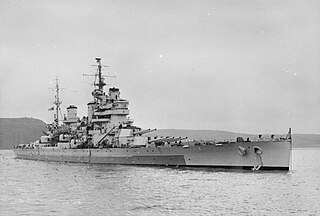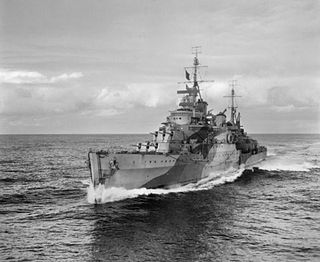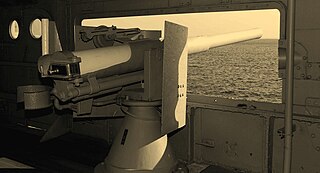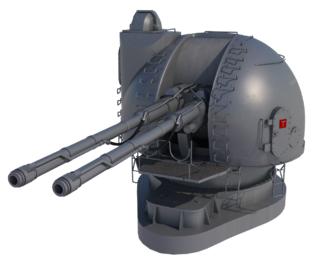
The Fiji-class cruisers were a class of eleven light cruisers of the Royal Navy that saw extensive service throughout the Second World War. Each ship of the class was named after a Crown colony or other constituent territory of the British Commonwealth and Empire. The class was also known as the Colony class, or Crown Colony class. Developed as more compact versions of the preceding Town-class cruisers, the last three were built to a slightly modified design and were sometimes also called the Ceylon class.

HMS Duke of York was a King George V-class battleship of the Royal Navy. Laid down in May 1937, the ship was constructed by John Brown and Company at Clydebank, and commissioned into the Royal Navy on 4 November 1941, subsequently seeing combat service during the Second World War. In mid-December 1941, Duke of York transported Prime Minister Winston Churchill to the United States to meet President Franklin D. Roosevelt. Between March and September 1942 Duke of York was involved with convoy escort duties, including as flagship of the Heavy Covering Force of Convoy PQ-17, but in October she was dispatched to Gibraltar where she became the flagship of Force H.

HMS Anson was a King George V-class battleship of the Royal Navy, named after Admiral George Anson. She was built by Swan Hunter and Wigham Richardson Shipyard on the River Tyne and launched on 24 February 1940, being completed on 22 June 1942. Her completion was delayed to allow the fitting of fire-control radar and additional anti-aircraft weapons. She was originally to have been named Jellicoe, but was renamed Anson in February 1940.

The Town class consisted of 10 light cruisers built for the Royal Navy during the 1930s. The Towns were designed within the constraints of the London Naval Treaty of 1930. The ships were built in the sub-classes, Southampton, Gloucester and Edinburgh, each sub-class adding more weaponry.

The Dido class consisted of sixteen light cruisers built for the Royal Navy during World War II. The first group of three ships were commissioned in 1940; the second group of six ships and third group of two were commissioned between 1941 and 1942. A fourth group, also described as the Improved Dido or Bellona class were commissioned between 1943 and 1944. Most members of the class were given names drawn from classical history and legend. The groups differed in armament, and for the Bellonas, in function. The Dido class were designed to replace the C-class and D-class cruisers as small fleet cruisers and flotilla leaders for the destroyer screen. As designed, they mounted five twin 5.25-inch high-angle gun turrets on the centreline providing dual-purpose anti-air and anti-surface capacity; the complex new turrets were unreliable when introduced, and somewhat unsatisfactory at a time when the UK faced a fight for survival. During the war, the original 1939-42 ships required extensive refit work to increase electrical generating capacity for additional wartime systems and in the final Bellona,HMS Diadem, fully-electric turrets. While some damage was experienced initially in extreme North Atlantic weather, changes to gun handling and drill partially mitigated the problems. The fitting of the three forward turrets in the double-superfiring A-B-C arrangement relied upon the heavy use of aluminium in the ships' superstructure, and the lack of aluminium after the evacuation of the British Army from France was one of the primary reasons for the first group only receiving four turrets, while the third group received four twin 4.5-inch mounts and no 5.25-inch guns at all. The Bellonas were designed from the start with four radar-directed 5.25-inch gun turrets with full Remote Power Control and an expanded light anti-aircraft battery, substantially increasing their efficiency as AA platforms.

The Atlanta-class cruisers were eight United States Navy light cruisers which were designed as fast scout cruisers, flotilla leaders, or destroyer leaders, but which proved to be effective anti-aircraft cruisers during World War II. They were also known as the Atlanta-Oakland class. The Atlanta class originally had 16 x 5-inch (127 mm)/38 caliber guns in eight two-gun turrets, arranged with three superfiring turrets forward, three more superfiring aft and two waist mounts, one port and one starboard, giving the first four Atlanta-class cruisers the heaviest anti-aircraft armament of any cruiser of World War II. The last four ships of the class, starting with Oakland, had a slightly revised armament with a reduced main gun battery - the waist turrets being deleted - as they were further optimized for anti-aircraft fire in light of war experience.

The QF 4.5 inch gun has been the standard medium-calibre naval gun used by the Royal Navy as a medium-range weapon capable of use against surface, aircraft and shore targets since 1938. This article covers the early 45-calibre family of guns up to the 1970s. For the later unrelated 55-calibre Royal Navy gun, see 4.5 inch Mark 8 naval gun. Like all British nominally 4.5 inch naval guns, the QF Mk I has an actual calibre of 4.45 inches (113 mm).

A dual-purpose gun is a naval artillery mounting designed to engage both surface and air targets.

High Angle Control System (HACS) was a British anti-aircraft fire-control system employed by the Royal Navy from 1931 and used widely during World War II. HACS calculated the necessary deflection required to place an explosive shell in the location of a target flying at a known height, bearing and speed.

The Iowa-class battleships are the most heavily armed warships the United States Navy has ever put to sea, due to the continual development of their onboard weaponry. The first Iowa-class ship was laid down in June 1940; in their World War II configuration, each of the Iowa-class battleships had a main battery of 16-inch (406 mm) guns that could hit targets nearly 20 statute miles (32 km) away with a variety of artillery shells designed for anti-ship or bombardment work. The secondary battery of 5-inch (127 mm) guns could hit targets nearly 9 statute miles (14 km) away with solid projectiles or proximity fuzed shells, and was effective in an anti-aircraft role as well. Each of the four battleships carried a wide array of 20 mm and 40 mm anti-aircraft guns for defense against enemy aircraft.

The QF 6-inch 40 calibre naval gun (Quick-Firing) was used by many United Kingdom-built warships around the end of the 19th century and the start of the 20th century. In British service it was known as the QF 6-inch Mk I, II, III guns. As the 15 cm/40 (6") 41st Year Type naval gun it was used for pre-dreadnought battleships, armoured cruisers and protected cruisers of the early Imperial Japanese Navy built in UK and European shipyards. It was also the heaviest gun ever carried by a pre-Cold War destroyer.

The QF 12-pounder 12-cwt gun (Quick-Firing) was a common, versatile 3-inch (76.2 mm) calibre naval gun introduced in 1894 and used until the middle of the 20th century. It was produced by Armstrong Whitworth, Elswick and used on Royal Navy warships, exported to allied countries, and used for land service. In British service "12-pounder" was the rounded value of the projectile weight, and "12 cwt (hundredweight)" was the weight of the barrel and breech, to differentiate it from other "12-pounder" guns.

The Ordnance QF Hotchkiss 6 pounder gun Mk I and Mk II or QF 6 pounder 8 cwt were a family of long-lived light 57 mm naval guns introduced in 1885 to defend against new, small and fast vessels such as torpedo boats and later submarines. There were many variants produced, often under license which ranged in length from 40 to 58 calibers, but 40 caliber was the most common version.

The QF 4 inch Mk XVI gun was the standard British Commonwealth naval anti-aircraft and dual-purpose gun of World War II.

The BL 6-inch Mark XII naval gun was a British 45 calibre naval gun which was mounted as primary armament on light cruisers and secondary armament on dreadnought battleships commissioned in the period 1914–1926, and remained in service on many warships until the end of World War II.

The 4.7 inch QF Mark IX and Mark XII were 45-calibre, 4.7-inch (120 mm) naval guns which armed the majority of Royal Navy and Commonwealth destroyers in World War II, and were exported to many countries after World War II as the destroyers they were mounted on were sold off.

The 4.7 inch QF Mark XI was a 50-calibre, 4.7-inch (120 mm) naval gun mounted on Royal Navy (RN) and Allied destroyers during World War II.

The AK-130 is a Russian designed automatic dual barrel naval cannon with a caliber of 130 millimetres (5.1 in), capable of firing 10-40 rounds per minute.
The Minotaur class, or Design Z, was a proposed class of light cruisers planned for the British Royal Navy shortly after the Second World War. Design Z had several proposed configurations with differing armament and propulsion arrangements. The designs were large ships that were planned to be armed with ten 6 in (152 mm) dual purpose guns and an extensive array of 3 in (76 mm) secondary guns. Six ships of the class were planned in 1947 but they were ultimately cancelled before construction could begin, owing to the post-war economic difficulties of the United Kingdom and shifting naval priorities.

























